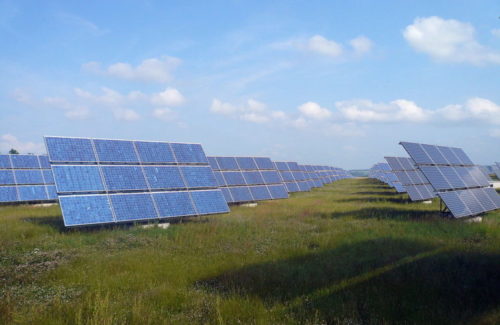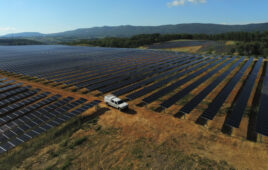By Dan Nordloh, executive vice president of EnSync Energy
In 2017, the United States doubled its total community solar capacity by installing 350 MW, bringing the total to 700 MW. Meanwhile, Minnesota installed more community solar than the rest of the country combined. Community solar is undoubtedly on an impressive rise, and much of that momentum is steered by the successes of previous solar models, especially commercial solar.
Commercial solar has been creative at finding new value-adds from which the community solar industry can learn. By looking to the technical insight of the established and growing commercial and industrial (C&I) sector—specifically around financing models, solar+storage and the advanced integration of distributed energy resources—community solar can carve its own paths to reach new levels of adoption and innovation.
 Modern financing to reduce the barriers to entry
Modern financing to reduce the barriers to entry
The first major hurdle in any project is financial viability: Show me the money. Commercial solar and now community solar are advancing beyond bureaucratic budgetary boundaries by systemizing structures for the private sector, consumers and third parties to partner and invest in energy infrastructure assets. The power purchase agreement (PPA) made famous in the commercial solar era will play a huge role in community solar. PPAs have enabled investors to participate in solar by taking on the risk of a solar project and allowed commercial energy consumers to participate by paying the project off as if it were a regular energy bill—and most often at a lower rate.
The innovative financing behind the energy exchange in the commercial solar sector is creating more winners. These PPAs now regularly assess more complex project finances, including solar+storage arrangements and more complex system interactions like utility rate structures. A new class of project analyzers skilled in system design and modeling that optimize financial economics has grown in the C&I solar sector and is ready to share that toolbox with community solar. The ability to optimally model for operational and financial performance creates the market opportunity by giving PPA investors confidence and details on how the system’s complexities are being considered and distilled into financial return.
The ultimate add-on: energy storage
Commercial solar began, similarly to community solar, as standalone solar. Like community solar, it flowed in one direction either to load needed at that time or it exported to the grid. At its core, community solar is an extension of C&I solar: energy generation models grounded in the value of distributed energy resources at scale. Both bring energy supply closer to the load than conventional utility generation assets and at a more expansive, economically feasible scale than residential solar.
Photovoltaics alone are undoubtedly valuable, especially economical for operations with large energy consumption during peak solar hours like universities and schools. What the commercial sector has been able to perfect is elevating the value of standalone solar with solar+storage.
In the on-demand modern lifestyle, businesses and consumers demand constant supply of energy at all times. In fact, many industries rely on continuous power in the commercial space, from agriculture and food processing to data management and communications. The reliable flexibility of energy supply supplemented by storage offers huge value to commercial customers seeking the greater returns and resiliency of self-generated energy. The commercial sector has been the leading champions of the energy independence solar+storage offers. GTM Research estimates that the growth of storage in the commercial, industrial, and institutional sector will be the reason that customer-sited storage will account for half the storage market by capacity in 2021.
Will storage enter the community solar mainstream market? Very probably. Community storage plans are popping up in a handful of states, and Massachusetts recently secured a utility PPA for its first community solar+storage project. The commercial sector has driven understandings of the battery chemistries needed to offer different types of energy—from high voltage power to constant energy. Strides in C&I projects have also evolved infrastructure designs to better support more integrated distributed energy resources, like the rise of direct current-supported energy systems that make exchanges more efficient. These technical feats offer a blueprint for community solar to make the storage add-on a regular reality.
Dispatchable energy will easily fit in with community solar’s model, which already is based on virtually matching demand with supply with net metering. This will be particularly attractive as many net-metering programs sunset across the country.
Raising the intelligence of grid assets
Once C&I facilities could achieve solar energy in dispatchable, cheap forms, the next evolutionary step came with the services that dispatchable power could deliver and the intelligence added to systems to make it happen. Through solar+storage developments, bi-directional power became the norm, and the different value mechanisms that resulted (such as using stored solar energy for peak shaving or demand response) were commercial solar’s key to unlocking the full power.
 Commercial sites are adding more granular computing capabilities to the different components of their energy systems and enabling greater collaboration among energy generation, grid parameters and load needs, which creates benefits across the stakeholder chain. Utilities can securely tap into customer-sited distributed energy resources when their system peak is getting too high. Commercial operations are set to be responsive to market pricing, configuring their machines to run during cheap energy hours like when their solar panels are generating energy or during off-peak hours like at night. This level of orchestrated intelligence— happening at a micro-level on a commercial site between equipment loads—could expand to a community solar macro-level, connecting and optimizing different home loads with solar generation and batteries.
Commercial sites are adding more granular computing capabilities to the different components of their energy systems and enabling greater collaboration among energy generation, grid parameters and load needs, which creates benefits across the stakeholder chain. Utilities can securely tap into customer-sited distributed energy resources when their system peak is getting too high. Commercial operations are set to be responsive to market pricing, configuring their machines to run during cheap energy hours like when their solar panels are generating energy or during off-peak hours like at night. This level of orchestrated intelligence— happening at a micro-level on a commercial site between equipment loads—could expand to a community solar macro-level, connecting and optimizing different home loads with solar generation and batteries.
More businesses and homes will come equipped with energy processing intelligence in the form of system controls for storage and solar generation capabilities. With this greater intelligence, more exchanges will happen at the peer-to-peer level, symbolizing the next evolution from bi-directional power to the transactive energy marketplace. In this transactive marketplace facilitated by distributed intelligence, not only will utilities look to leverage community solar assets for grid services—as they do now with C&I—but so will nearby consumers. The sharing economy that is propelling new business models and lifestyle habits worldwide makes community-oriented models like this an easy leap for consumers.
Net metering has long been the value translation for exported energy generation, but the permanence of programs is never guaranteed. As utility policies around net metering ebb and flow, heightened levels of intelligence and interconnection can leverage more granular data to monitor, analyze and control energy systems and ultimately offer the least expensive, most reliable power. As with C&I systems, community solar that is engineered with modular and adaptable control technologies can deliver benefits today and well into the future for all parties in the electricity marketplace, minimizing reliance on any single policy such as net metering.
Markets just adopting community solar will be able to ramp up quickly from lessons learned from the commercial sector across innovative financing, solar-plus-storage and distributed resource intelligence. Community solar will also have a lasting influence on commercial solar in its scale and reach for participation. Community solar enables more populations to participate—most notably, the simple ratepayer—opening new markets for commercial solar energy developers. Through this greater mobilization, community solar can push the concepts commercial solar developed even further and create its own compelling storyline.





Very well written. Articles on how to educate the monopoly-based utilities to embrace this–stop fighting it–would be helpful.
Our company has the storage answer but needs help on the revenue side–standardizing the value of services storage delivers would explode the market. The fractured market, created by franchised territory allocations, leaves those of us trying to help, stuck with trying to sell to many kings (FL has 58 power companies). Kings that have been very happy for a 100 years–now in a panic as customers (best ones first) leave their ranks. If, together, the pieces of our industry could solicit guidelines–this could encourage power companies to take a chance without fearing another Enron chapter…